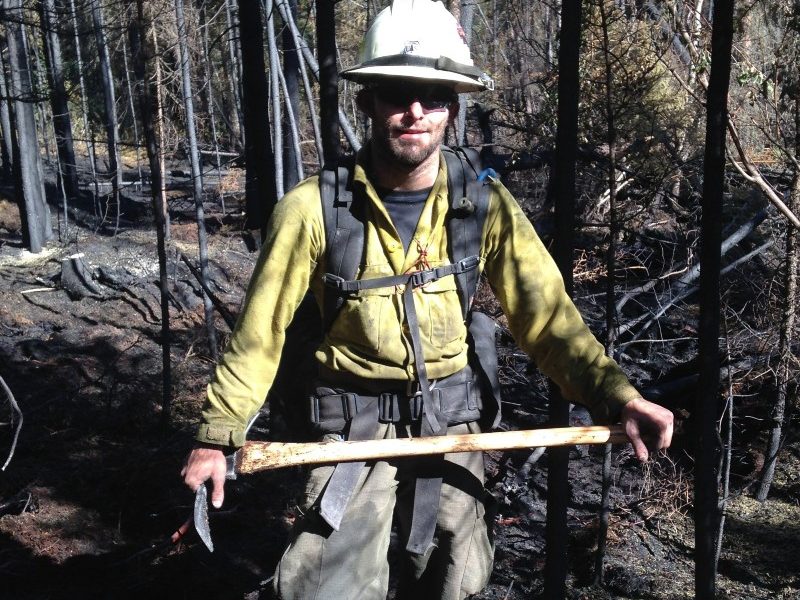In the summer of 2015, over two hundred fires blazed across Canada. I’d been with the San Juan Hotshots in Colorado as a detailer for just a short while when we were given the resource order to depart to Alberta to help, alongside several other American hotshot crews.
I was lucky enough to have an up-to-date passport, and ready to head north as I could ever be. The weather in Colorado was rainy that summer, so we had a light fire season that freed us up to help the Canadians. A few days after getting the order, I stood on the tarmac in my hometown, Grand Junction, and watched as a government-contracted 737 came in for a landing. We loaded up our gear in the belly of the plane and took off.
When we landed in Edmonton, the stifling weather was a stark contrast to Colorado’s showers. The hot sun beat down through the dry air—perfect fire conditions.
The Canadian firefighting leadership briefed us on how they did things up there. With as much acreage and remote forest and mountain territory they cover, they rely more heavily on aircraft than we do. When it comes to fighting fire, there’s apparently more than one way to skin a moose.

The boreal forest in the Canadian north.Our northern friends hooked us up with chainsaws and Pulaskis, then we drove four hours north. We watched transfixed through the truck windows as the plains around Edmonton gave way to what we’d be working through—a broad and thick, almost impenetrable expanse of boreal forest.
We arrived at the Loon River Airtanker Base in the middle of the wilderness on our first full day in country. There on the tarmac stood more planes and choppers than employees who even worked there. Our job was to put down the more remote fires that were not close to any towns or development. Though remote, these blazes were anything but small. The largest fire we battled was around 27,000 hectares—nearly to 66,800 acres. We hopped from fire to fire with helicopters as our sole mode of transportation, knocking down fires as hard as we could.

Firefighting in the boreal forest was a challenge none of us anticipated. The forest floor is a three-feet-deep mess of duff and litter and root mass, which we had to cut through to get down to the ancient glacial till sand below it. In most fires in the states, cutting a line through to the mineral soil isn’t as hard and can be done with basic tools and saws. But this was a whole different beast. We actually laid hose and hit it with water because there’s a lot of room within that three-foot mess of fuel for fire to smolder. Wildland firefighting with a hotshot crew doesn’t often involve water suppression, so this was all new to me. Fortunately, with as many swamps and lakes surrounding us, we never had a hard time getting water when and where we needed it.
Though the work was hard and the northern days were long, the Canadians kept us extremely well fed with excellent food delivered daily by helicopters and a bit of good humor when they stopped by to have a chat.

To top this trip off, I left Colorado as a 20-year-old juvenile and returned a 21-year-old man. In a country where the drinking age is 19, this shouldn’t have mattered too much to our Canadian friends, but somehow the word got around. As we worked on the line on the day of my birthday, a helicopter arrived to deliver our dinner. And with it, a magnificent cake with my name on it. (And I can neither confirm nor deny the presence of a couple of Bud Lights.) No detailer ever had a better birthday on a hotshot crew.

We were in the country for 14 days, and we’d dug over four miles of line and deployed hose all over it. I admit to being disappointed when we inspected the map, because with the overall picture of the fire, it didn’t look like we’d made even a dent in the 66,800 acres, which is understandable. For each mile of mapped perimeter, there was at least four miles of line due to curve and fingers in the fire area that other crews were responsible for. I left Canada with a newfound respect for the crews who dug their lines and who fight for their country’s pristine wilderness every summer. It was an experience I will never forget, and it would be my honor to join my friends up north again in the future.
Shortly after we returned home, I packed up and returned to school to finish my last year of college, with dreams of the fire line and memories of my friends I’d met that summer punctuating every day. I spent my next year in fire on a long-term detail with San Juan, and then finally landed an official job on the crew in 2017. This year will be my second season as a proud San Juan Hotshot.
![]()
